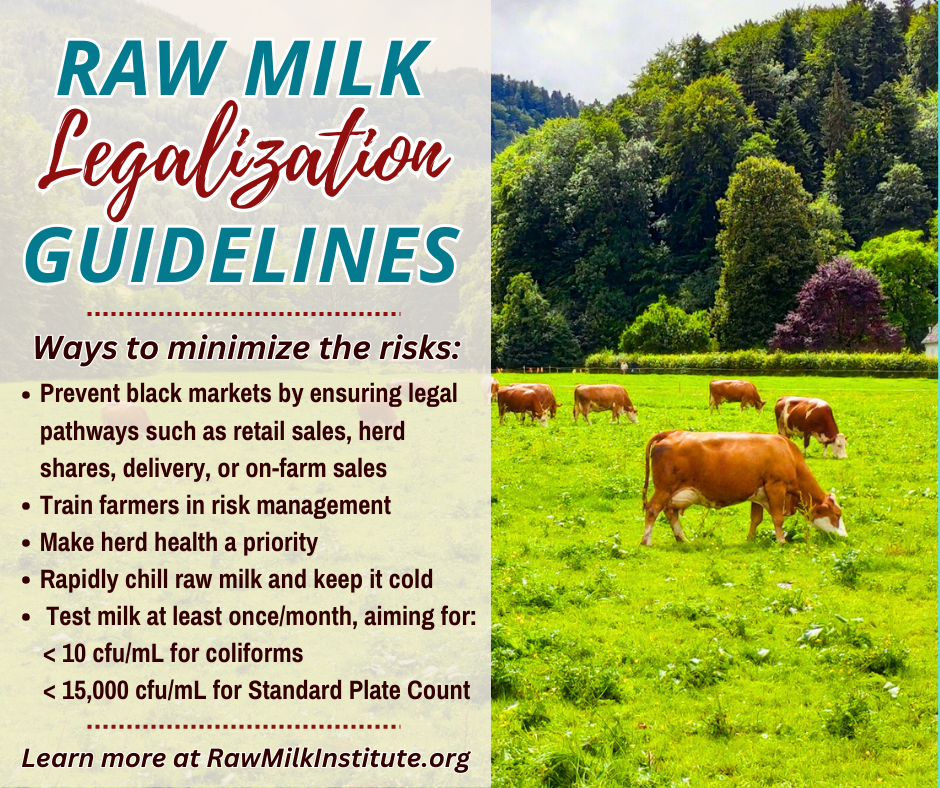The Raw Milk Institute is frequently asked to weigh in on legalization of raw milk in various states and countries. To that end, we have developed the following policy brief as a reference for legislators, policy makers, and legalization advocates.
Raw Milk Legalization Policy Brief
Executive Summary
Consumers are demanding increased access to raw milk as a fundamental, health-supporting food. Raw milk can be produced as a low-risk food when farmers 1) are well-trained, 2) use specialized practices for mitigating risks on their unique farms, and 3) perform ongoing bacterial testing of their milk to ensure high standards.
The Raw Milk Institute is in support of increased legalization. Raw milk is already legal in over half the states in the USA as well as many European countries including the United Kingdom, France, Italy, and Switzerland. Raw milk provides a pathway to economic viability for failing family farms when they focus on quality instead of quantity.
Raw Milk Risk Management Works
There is no such thing as a perfectly safe food. A CDC analysis of foodborne illnesses showed that a wide range of foods including meats and vegetables are known to have the potential for causing foodborne illnesses, with chicken, pork, and seeded vegetables topping the list. Pasteurized milk is not perfectly safe, either, and is implicated in foodborne illnesses and outbreaks every year.[1]
Nonetheless, only raw milk is targeted by government regulators as a food to be completely avoided. Many foods, including raw milk, warrant concern for pathogens if not managed appropriately. Two studies have shown that raw milk can be carefully produced as a low-risk food.
Recent Trends in Unpasteurized Fluid Milk Outbreaks, Legalization, and Consumption in the United States (PLOS One 2018)
The authors concluded that, “Controlling for growth in population and consumption, the [raw milk] outbreak rate has effectively decreased by 74% since 2005.” The study suggested that the improving food safety record is the result of expanded safety training for raw milk dairy producers.[2]
Raw Milk Producers with High Levels of Hygiene and Safety (Cambridge Journal of Epidemiology and Infection 2020)
Data show that raw milk being intentionally produced for human consumption is fundamentally different from pre-pasteurized milk that is taken from bulk tanks. It was concluded that "raw milk can be produced with a high level of hygiene and safety.” This paper provides further proof that, with farmer training, careful production practices, and ongoing testing, low-risk raw milk is achievable. [3]
Benefits of Raw Milk
Immune System Support: Like breastmilk, raw milk supports strong immune systems. Large epidemiological studies have found that raw milk consumption is correlated with lower rates of asthma, eczema, allergies, ear infections, fevers, and respiratory infections.[4-6]
Improved Digestion: Pasteurized milk is a top food allergen and difficult to digest. Raw milk is unlikely to induce allergies and it facilitates production of lactase enzyme in the intestinal tract. Thus, many people who are lactose intolerant have no issues digesting raw milk.
Sustainable Pathway for Family Farms: Instead of continuing to struggle to make ends meet, raw milk farmers can thrive by selling directly to good-paying customers.
Legalization Guidelines
When raw milk is illegal, the demand will be supplied by neighboring states/countries as well as a black market where farmers are less likely to use recommended production practices. Regulatory agencies can improve the safety of raw milk in the following ways.
Ensure there are legal pathways to raw milk access, such as retail sales, herd shares, delivery, and/or on-farm sales.
Require raw milk farmers to attend training, such as the Raw Milk Institute’s 4-Hour Risk Management Training (which is freely available online).[7]
Require that all dairy animals be free of Tuberculosis, Brucellosis, and Johne’s.
Ensure that raw milk from multiple farms cannot be commingled.
Recommend that raw milk be chilled to <40°F within an hour after milking and maintained at <40°F in storage and transport.
Require farmers to test their milk at least once per month, at either an on-farm lab or an offsite lab, with the goal of achieving a 3-month rolling average of:
<15,000 cfu/mL for Standard Plate Count
<10 cfu/mL for coliforms
References
CDC MMWR (2018). Surveillance for Foodborne Disease Outbreaks — United States, 2009–2015. https://www.cdc.gov/mmwr/volumes/67/ss/ss6710a1.htm
Whitehead, J., & Lake, B. (2018). “Recent Trends in Unpasteurized Fluid Milk Outbreaks, Legalization, and Consumption in the United States.” PLoS currents, 10, https://www.ncbi.nlm.nih.gov/pmc/articles/PMC6140832/
Berge, A C, and T Baars. “Raw milk producers with high levels of hygiene and safety.” Epidemiology and infection vol. 148 e14. 31 Jan. 2020, https://pubmed.ncbi.nlm.nih.gov/32000877/
Loss, Georg et al. “The protective effect of farm milk consumption on childhood asthma and atopy: the GABRIELA study.” The Journal of allergy and clinical immunology vol. 128,4 (2011): 766-773.e4. https://pubmed.ncbi.nlm.nih.gov/21875744/
Brick, Tabea et al. “The Beneficial Effect of Farm Milk Consumption on Asthma, Allergies, and Infections: From Meta-Analysis of Evidence to Clinical Trial.” The journal of allergy and clinical immunology. In practice vol. 8,3 (2020): 878-889.e3. https://pubmed.ncbi.nlm.nih.gov/31770653/
Loss, Georg et al. “Consumption of unprocessed cow's milk protects infants from common respiratory infections.” The Journal of allergy and clinical immunology vol. 135,1 (2015): 56-62. https://pubmed.ncbi.nlm.nih.gov/25441645/
Raw Milk Institute (2021). Raw Milk Risk Management Training Videos. https://vimeo.com/showcase/8619574




